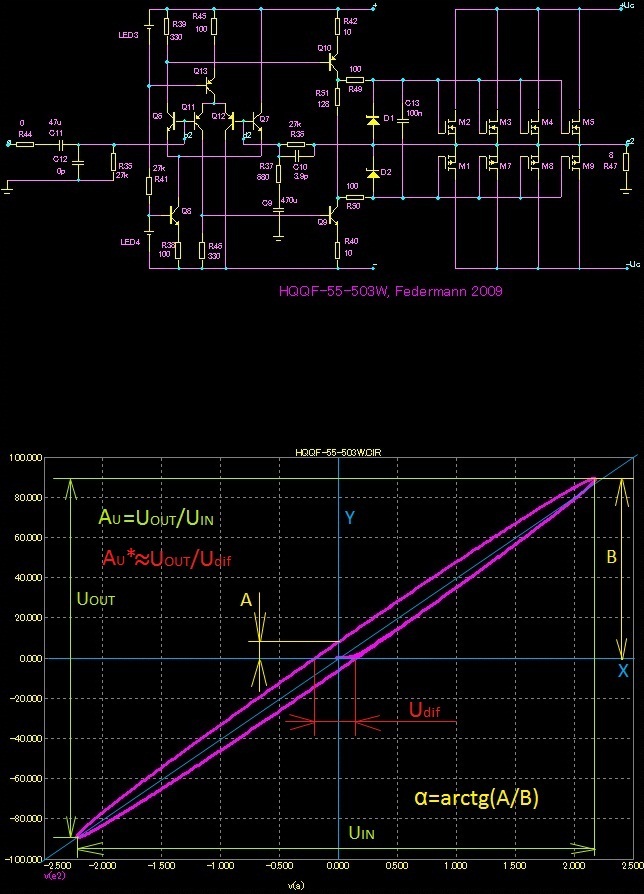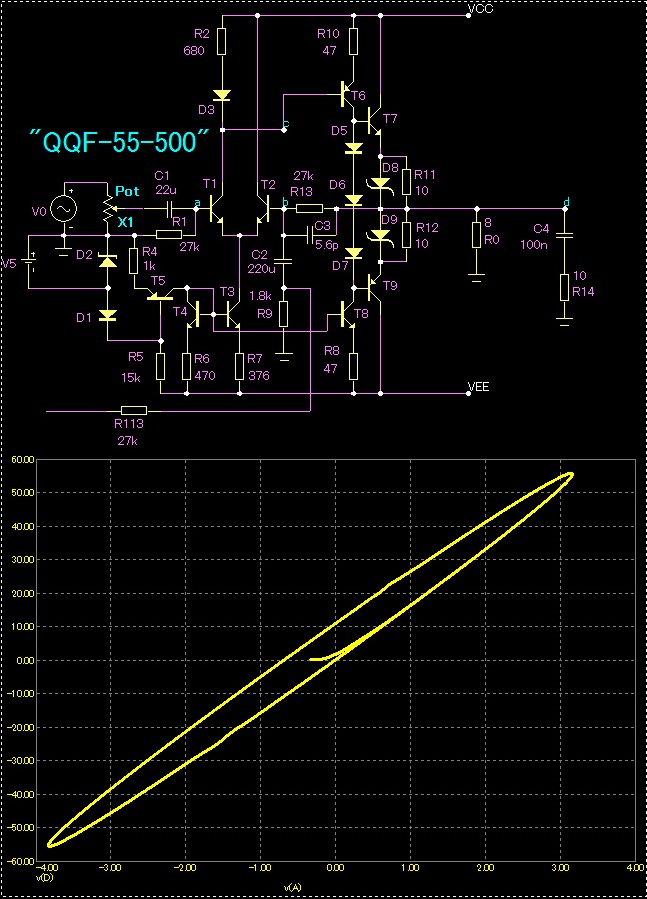MOSFET simulator models are quite incomplete and do not fit to real devices well.
If you do not model, write down the models better. Write to such models in order to avoid mistakes. If your model is not enough, write Macro. More I can not advise.
Federmann;2024153[snip said:. I do not want to persuade anybody, it's my view, these are my conclusions. Everyone has the right to have their own opinion, but time will tell which view was right.
Federmann, I don't know if you understand what I am saying (I don't even know if you read any posts at all).
Everybody has indeed right to own opinion. But facts are not opinion. Two amp stages, even ONE follower, can oscillate. It may be your opinion that it cannot, but still it does, and 20 minutes on the test bench will show that.
Your opinion is worthless unless it is based on something factual or backed up by tests.
You clearly lack the fundamental understanding of feedback circuits. Nobody will blame you for that. What you can be blamed for is your absolute determination to stay ignorant in a sea of insight.
Just 10 minutes on any simulator thread here on diyaudio.com will show you that simulators lie more often than not. Yet you are totally ignorant about that.
So, while I admire your determination, I will predict that nothing comes out of it, because you lack the things that are necessary to find something new: self-criticism and to learn what is already found by others. This is a pity, because so much effort by you is totally wasted. For 2010 I wish you a lot of insight, and I don't mean audio.
jd
Simulators do not make mistakes.
Mistakes only make people who have not entered any data. Please enter the simulator, parasitic inductance, capacitance and resistance, everything will be fine.
Simulators simulate circuits with billions of transistors and people do it.
This is trully bizarre... you are implying you enter all the data, all the parasitics, presumably knowing what these all are when a circuit is built too
So you don't build or measure any of your theoretical circuits here. I have the greatest admiration for folk who use simulators as a starting point and to help develop designs, but you are saying that you believe that this is all that is required... that the building, testing and "real world" measurements are not required...
Have I (we) understood you correctly...
This is trully bizarre...
...
SPICE-compatible is my assistant not my master.
Federman,
You are showing only sad illustration of the fundamental misunderstanding of context. Phase shift is the inevitable consequence of the final frequency range, not vice versa, increasing Vdif as much as it inevitably falls OLG, so distortion with frequency is increasing. However you can not removed this simply by increasing OLG gain to "infinity", (eg by omitting degeneration in dff. Iinput)as you hope, because you get not an amplifier, but oscilator, certainly with showed PCB.
I see here only one dangerous "delay", it is big delay in yours knowledges.
You are showing only sad illustration of the fundamental misunderstanding of context. Phase shift is the inevitable consequence of the final frequency range, not vice versa, increasing Vdif as much as it inevitably falls OLG, so distortion with frequency is increasing. However you can not removed this simply by increasing OLG gain to "infinity", (eg by omitting degeneration in dff. Iinput)as you hope, because you get not an amplifier, but oscilator, certainly with showed PCB.
I see here only one dangerous "delay", it is big delay in yours knowledges.
Federmann, I wish to honestly say that as drawn, your amplifier will oscillate and even blow up, due to REAL devices, especially the mosfets, and difficult loads, such as real loudspeakers, wire, etc. However, I like your principle, and I think that in an ideal world, it is a good approach. If you can, please read Solomon: 'A Monolithic Operational Amplifier: A Tutorial Study', hopefully for increased insight of real world limitations of actual devices, and how they compromise an 'ideal' design. I realize that you are more sophisticated than this tutorial implies, but you appear to overlook important problems, that if not considered, will make any practical effort, useless. Also we should talk to Kirkwood Rough, who is a mosfet designer, who can help here. He is on this website as well.
Federmann, I think that you feel that you are needlessly diverted by REAL aspects of amp design, that if taken to extremes, might dilute your theoretical efforts. You might be correct, and I wish that your countrymen, as well as other critics, would back off, so what you are trying to say, is what is discussed here. I personally have not gone through every graph, and sometimes I even have trouble reading your graphs, and what they actually mean. In other words, what might be obvious to you, might not be to me.
Still, any deviation in a differential input in this design, which generates the amplification of the input signal, will MODULATE the output phase shift, and this could be important. It is not easily measured, because we do not measure the FM component of amps, normally, and any signal will create some FM component, but the very nature of the design, UNLESS the open loop bandwidth is greater than the working bandwidth.
Still, any deviation in a differential input in this design, which generates the amplification of the input signal, will MODULATE the output phase shift, and this could be important. It is not easily measured, because we do not measure the FM component of amps, normally, and any signal will create some FM component, but the very nature of the design, UNLESS the open loop bandwidth is greater than the working bandwidth.
Federmann, I think that you feel that you are needlessly diverted by REAL aspects of amp design, that if taken to extremes, might dilute your theoretical efforts. You might be correct, and I wish that your countrymen, as well as other critics, would back off, so what you are trying to say, is what is discussed here. I personally have not gone through every graph, and sometimes I even have trouble reading your graphs, and what they actually mean. In other words, what might be obvious to you, might not be to me.
Still, any deviation in a differential input in this design, which generates the amplification of the input signal, will MODULATE the output phase shift, and this could be important. It is not easily measured, because we do not measure the FM component of amps, normally, and any signal will create some FM component, but the very nature of the design, UNLESS the open loop bandwidth is greater than the working bandwidth.
John,
I have not been following this thread closely, but I must say once again that as long as the CLOSED LOOP bandwidth is the same, a given amount of nonlinearity in the input stage will create the same amount of PIM, or FM distortion, as you call it. Open loop bandwidth has no direct influence on the propensity of an amplifier to generate PIM as long as apples are compared to apples.
It is also important to realize that PIM WILL show up as sidebands in a 19+20 kHz CCIF IM test.
It is also true that it is virtually impossible for an amplifier to create PIM without also creating a substantial amount of AIM. This is because PIM usually results from an amplitude-to-phase conversion, and that conversion is far less than 100% efficient.
Lastly, as I have pointed out before, the mechanism of input stage nonlinearity for creation of PIM that you discuss is not the only source of PIM. Amplifiers create PIM in the open loop as well. Indeed, open-loop PIM tends to be reduced by the application of negative feedback, as are most other distortions. This means that even Charles Hansen's no NFB amplifier will exhibit measurable PIM.
The video people were wrestling with PIM decades before it was known as PIM. It was called differential gain and phase. The audio community just re-named it AIM and PIM.
Merry Christmas,
Bob
Please don't confuse the issue, Bob. We all know your opinions on the subject. You will also find that most video amps with the same basic topology as Scott Wurcer's AD797 have MUCH higher open loop bandwidths. Could the be because of the need to linearize the input diff pair, and the advantage (for some reason) to have a high open loop bandwidth, perhaps for minimum differential phase?
nothing to add.
You are probably the closest to a possible implementation. I ask for a transfer characteristic for 100kHz? Please measured and simulated. Result many clue.
Also, I wish everyone a pleasant Merry Christmas and a lot of fun, and a lot of fun...
Bobby
Last edited:
- Status
- This old topic is closed. If you want to reopen this topic, contact a moderator using the "Report Post" button.
- Home
- Amplifiers
- Solid State
- Influence of the delay amplifiers for listening characteristics

